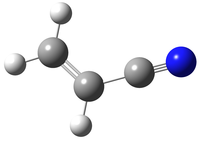|
The spectroscopic parameters and the experimental
transition frequencies were published in
(1) H. S. P. Müller, A. Belloche, K. M. Menten,
C. Comito, and P. Schilke,
2008, J. Mol. Spectrosc. 251 319.
Besides from this work, the data originate
from
(2) J. M. Colmont, G. Wlodarczak, D. Priem, H. S. P.
Müller, E. H. Tien, R. J. Richards, and M. C. L. Gerry,
1997, J. Mol. Spectrosc. 181, 330.
Data with experimental uncertainties larger than
200 kHz have not been merged.
Predictions with uncertainties exceeding about 1 MHz
should be viewed with increasing caution.
14N hyperfine splitting may be resolved
for low values of J. Therefore, a
separate hyperfine calculation is provided for a-type
R-branch transitions with J' ≤ 5
and frequencies below 50 GHz.
NOTE: The partition function
does take into account the spin multiplicity
gI = 3 of the 14N nucleus !
Furthermore, energy levels up to J = 170 and
Ka = 50 have been considered in the calculation of
the partition function. This is sufficient up to 300 K.
At higher temperatures classical extrapolations are recommended.
The partition function does not include contributions from
low-lying vibrational modes. Estimates for these corrections are
available for the main isotopic species, see e053515.cat.
The dipole moment was assumed to agree with that of
the main isotopic species, see e053515.cat.
|
